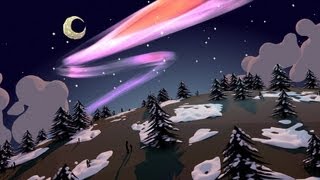(单词翻译:单击)
Every second, one million tons of matter is blasted from the Sun at the velocity of one million miles per hour,
每一秒,太阳喷发出一百万吨的物质,时速一百六十万公里,
and it's on a collision course with Earth!
这些物质还与地球相碰撞!
But don't worry, this isn't the opening of a new Michael Bay movie.
但别担心,这可不是变形金刚导演麦可·贝的新科幻电影片头。
This is The Journey of the Polar Lights.
这是极光之旅。
The northern and southern lights, also known as the aurora Borealis and aurora Australis, respectively,
北方的光与南方的光,分别称为北极光及南极光,
occur when high energy particles from the Sun collide with neutral atoms in our atmosphere.
在来自太阳的高能粒子与我们大气层里的中性原子相撞时产生。
The energy emitted from this crash produces a spectacle of light that mankind has marveled at for centuries.
这种碰撞会放射出能量,产生一种光的奇景,数世纪来人类于此现象感到惊异。
But the particles' journey isn't just as simple as leaving the Sun and arriving at Earth.
但是粒子的旅程可不是从太阳出发然后抵达地球这么简单。
Like any cross-country road trip, there's a big detour and nobody asks for directions.
就像所有的开车长途旅行,常常绕来绕去,也没人要问路。
Let's track this intergalactic voyage by focusing on three main points of their journey:
让我们来追踪一下这个星际奇航吧,焦点放在此行的三个主要地方:
leaving the Sun, making a pit stop in the Earth's magnetic fields, and arriving at the atmosphere above our heads.
离开太阳,在地球的磁场短暂停留,然后抵达我们头上的大气层。
The protons and electrons creating the northern lights depart from the Sun's corona.
产生北极光的质子与电子,从太阳的日冕出发。
The corona is the outermost layer of the Sun's atmosphere and is one of the hottest regions.
日冕是太阳大气的最外层,也是最高温的地方。
Its intense heat causes the Sun's hydrogen and helium atoms to vibrate
超高的热度导致太阳的氢原子及氦原子振动,
and shake off protons and electrons as if they were stripping off layers on a hot, sunny day.
将质子及电子分离,就好像在晴朗炎热的日子一件件脱掉衣服一样。
Impatient and finally behind the wheel, these free protons and electrons move too fast to be contained by the Sun's gravity
急躁着想出门,最后终于上了驾驶座,这些自由的质子及电子运动速率极快,快到连太阳的重力都抓不住了,
and group together as plasma, an electrically charged gas.
并集中在一起成为等离子区,即一种带电的气体。
They travel away from the Sun as a constant gale of plasma, known as the solar wind.
它们从太阳出发,乘坐一阵阵的等离子风离开,一般称为太阳风。

However, the Earth prevents the solar wind from traveling straight into the planet by setting up a detour, the magnetosphere.
然而,地球为避免太阳风直接撞击,就让它们绕道,因而设下磁层。
The magnetosphere is formed by the Earth's magnetic currents
磁层由地球的磁流形成,
and shields our planet from the solar winds by sending out the particles around the Earth.
把围绕在地球四周的粒子往外推,保护我们的星球不被太阳风直接打到。
Their opportunity to continue the journey down to the atmosphere comes when the magnetosphere is overwhelmed by a new wave of travelers.
太阳风所带的离子在磁层无法负荷时,也可能往下进入大气层。
This event is coronal mass ejection, and it occurs when the Sun shoots out a massive ball of plasma into the solar wind.
这种情况称为日冕物质抛射,在太阳往太阳风里发射一大团等离子体时发生。
When one of these coronal mass ejections collides with Earth,
当其中一个日冕物质抛射与地球相撞时,
it overpowers the magnetosphere and creates a magnetic storm.
使磁层超负荷,并产生磁暴。
The heavy storm stresses the magnetosphere until it suddenly snaps back,
强烈磁暴冲击磁层,直到磁层突然恢复到原状,
like and overstretched elastic band, flinging some of the detoured particles towards Earth.
就像伸展过度的橡皮筋,把一些已经绕开的粒子抛向地球。
The retracting band of the magnetic field drags them down to the aurora ovals, which are the locations of the northern and southern lights.
往回缩的磁场将这些粒子拉进极光椭圆区,即发生北极光和南极光的位置。
After traveling 93 million miles across the galaxy,
在经过穿越银河系的九千三百万英里以后,
the Sun's particles finally produce their dazzling light show with the help of some friends.
这些太阳的粒子终于在一些朋友的帮助下,上演了它们炫目的光影表演。
20 to 200 miles above the surface, the electrons and protons meet up with oxygen and nitrogen atoms,
在地表上空的二十到两百英里处,那些电子和质子与氢和氮原子相遇,
and they sure are happy to see each other.
它们当然很高兴见到彼此。
The Sun's particles high five the atoms, giving their energy to the Earth's neutral oxygen and nitrogen atoms.
这些太阳粒子与那些原子击掌,将能量传给地球的中性氧原子及氢原子。
When the atoms in the atmosphere are contacted by the particles, they get excited and emit photons.
当大气层里的原子被那些粒子碰触后,它们激动起来并发射光子。
Photons are small bursts of energy in the form of light.
光子是能量以光的形式的小爆发。
The colors that appear in the sky depend on the wavelength of the atom's photon.
在天空中出现的极光颜色,取决于原子射出的光子的波长。
Excited oxygen atoms are responsible for the green and red colors,
激发态的氧原子产生绿光及红光,
whereas excited nitrogen atoms produce blue and deep red hues.
而激发态的氢原子则产生蓝光及深红色光。
The collection of these interactions is what creates the northern and southern lights.
这些交互作用加起来就产生了北极光与南极光。
The polar lights are best seen on clear nights in regions close to magnetic north and south poles.
欣赏最佳极光是要在地磁北极与地磁南极附近的晴朗夜晚。
Nighttime is ideal because the Aurora is much dimmer than sunlight and cannot be seen in daytime.
夜晚之所以理想,是因为极光比阳光暗很多,在白天是看不到的。
Remember to look up at the sky and read up on the Sun's energy patterns,
记得仰望天空并仔细研究太阳的能量模式,
specifically sunspots and solar flares, as these will be good guides for predicting the auroras.
特别是太阳黑子和太阳耀斑,因为这些将是预测极光的好向导。


